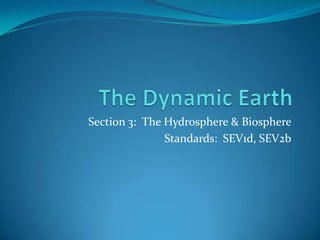
Unit 1 ch3 s3 the hydrosphere & biosphere
- 1. Section 3: The Hydrosphere & Biosphere Standards: SEV1d, SEV2b
- 2. What is the hydrosphere? All the water on or near the Earth’s surface. Includes Oceans Lakes Rivers Wetlands Icecaps Clouds Soil Rock layers beneath surface
- 3. What are the parts of the hydrologic (water) cycle? Evaporation Heated by sun & turns into water vapor Comes from bodies of water, plants (transpiration), and animals Condensation Water vapor forms droplets on dust particles, form clouds when they collide & stick Precipitation Large droplets fall from clouds Can be rain, snow, sleet, hail Runoff/Percolation Water can run off land into nearest body of water Water can percolate through layers of soil and get stored underground in aquifers.
- 4. How is water distributed on Earth? 97% salty ocean water 3% freshwater Of the 3%... 2% is unusable icecaps & glaciers 1% is usable surface or groundwater.
- 6. What is the difference between ocean water & freshwater? Ocean water is 3.5% salt. Salt comes from erosion from rocks on land over millions of years and underwater volcanic eruptions. Salinity can vary depending on depth of ocean & areas of evaporation EX: estuary- where freshwater river meets ocean.
- 7. What are the major oceans of the world? Pacific Largest ocean 165,640,000 km2 & avg. depth is 4,280 meters Deepest point (11,033 m) is Challenger Deep near Philippines. Divided into North Pacific- above equator and flows clockwise South Pacific- below equator and flows counterclockwise
- 8. What are the major oceans of the world? Atlantic Second largest ocean 81,630,000 km2 Like Pacific, divided into north & south with clockwise & counterclockwise movement.
- 9. What are the major oceans of the world? Indian Third largest ocean 73,420,000 km2 Average depth is 3,890 meters
- 10. What are the major oceans of the world? Arctic Smallest ocean 14,350,000 km2 Covered by floating ice called pack ice
- 11. What are the temperature zones of the ocean? Surface zone Warmed by sun Can be mixed with cooler layers below Thermocline Middle layer where temperatures drop fast with increased depth Deep zone Coldest layer b/c sun does not reach
- 12. What is the relationship between the ocean and atmosphere? Ocean has the ability to store and radiate heat to help control Earth’s temperature. Absorbs over half the solar radiation that reaches the Earth’s surface Direction of ocean current creates climates in inland areas. EX: warm Gulf currents bring warm moist air over north to British Isles
- 13. Where is usable freshwater found? Surface water Moving water Fast, cold, more oxygen Rivers, streams Watershed- area of land that dumps into a tributary. Tributaries- small streams that empty into larger river systems. EX: MHS campus is watershed for Noses creek which is a tributary to the Chattahoochee River McEachern Standing water High School Slow, warm, less oxygen Lakes, ponds, reservoirs
- 15. Where is usable freshwater found? Groundwater Water the seeps through soil and gets stored in underground rock formations called aquifers Surface of land where water seeps is called recharge zone.
- 16. MAJOR AQUIFERS OF THE UNITED STATES
- 17. What is the biosphere? Narrow layer around Earth’s surface in which life can exist. Layer that gets sunlight for plants, which provide for animals Also layer that has water, energy and moderate temperatures Consists of Uppermost part of geosphere Most of the hydrosphere Lower part of the atmosphere.
- 18. What is the difference between an open & closed system? Closed system- energy enters and leaves but matter does not. EX: Earth- energy from sun enters & reradiates but energy trapped by plants (and eventually animals) does not leave Earth. Open system- both matter & energy are exchanged by a system. EX: When Earth was first forming it was open because constantly hit by comets & meteors
Notas del editor
- The Challenger Deep is deep than Mount Everest is tall.
- What’s in a name?Powder Springs HistoryLand was incorporated as Springville which was originally occupied by 2 Cherokee Indian chiefs- Chief Noses (namesake of Noses Creek) and Chief Ana Kanasta (Sweetwater.) Originally called Springville because had 7 major minerals found in water that were considered to have health benefits. Also called Gunpowder Springs because the minerals turned the sand in the streams black. Used to be several natural springs that spouted from ground but water pressure in aquifer is now too low for the water to “squirt” out.